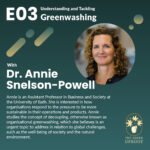As an industry, pharmaceutical companies are seen as leaders in sustainability, as this has been considered by the big pharmaceutical companies over the last 20 years (1). The sustainability of a product must consider all aspects of its life cycle, discovery, production, supply chain & logistics, packaging, and disposal. Pharmaceutical companies tend to focus on three major areas when improving sustainability (2). This includes the following:
Carbon footprint:
Pharmaceutical companies release 55% more carbon emissions than car manufacturers (3). Greenhouse gases are directly released into the atmosphere during the manufacturing and transportation of drugs/chemical products. Additionally, the development and production process require vast amounts of power, meaning there are indirect emissions from the production of this required power (2). For example, Sanofi powers its French sites using 100 per cent renewable electricity and aims to extend this to all its sites by 2030 (4).
Green chemistry:
Green chemistry is defined by the International Union of Pure and Applied Chemistry as “the invention, design, and application of chemical products and processes to reduce or to eliminate the use and generation of hazardous substances”. It is a fundamental aspect of the “green” pharmaceutical movement. Pfizer has published a guide for its chemists and engineers within the organisation (1).
Pharmaceutical pollution:
A pharmaceutical pollution is a form of water pollution where the pollutant is pharmaceutical drugs, the release of these drugs into water systems poses dangers to the environment and human health. The UN’s policy framework for the promotion of global chemical safety (Strategic Approach to International Chemicals Management) has identified pharmaceutical pollution as an emerging priority, especially regarding waste produced in the manufacturing of active pharmaceutical ingredients (2).
As mentioned in our Podcast episodes, transparency is a key factor in sustainability and greenwashing. There are some legal and regulatory bodies that require corporations to report their activities. The most noteworthy is the 2006 Companies Act passed by the British Government, which makes it compulsory to report on their environmental and social impacts and efforts (1). However, EcoAct’s 2021 Climate Reporting Performance report found that only 50% of pharmaceutical companies include climate risks in their annual reports. Indicating that climate change/sustainability is not considered a major issue to some companies in the sector. This also makes it more difficult to ‘fact check’ a company’s environmental claims if the information is not annually reported (4). Most companies report their sustainability activities in corporate social responsibility (CSR)/sustainability reports. Unfortunately, independent third parties often do not verify these reports, even for the largest companies. Only 40% of the Fortune Global 250 CSR reports had this external verification (5). This trend of a lack of authentication of sustainability reports produced by companies means greenwashing could very well be occurring.
Bayer (pharmaceutical and chemical company):
In 2015, Bayer launched a ‘Feed a Bee’ campaign. This campaign is in collaboration with government bodies, non-profit organisations, and businesses. It aims to distribute hundreds of thousands of wildflower seed packets, to plant thousands of acres of flower-producing crops grown between regular crop production periods (6).
As part of this campaign, Bayer has co-sponsored events such as the Pollinator Week event in Minnesota which was focused on making wildflower boutonnieres and planting flowers to help combat pollinator declines (7).
However, Bayer is one of the leading producers of neonicotinoid pesticides. These are widely used in agricultural, residential, and commercial areas as pest control and are a key driver in the decline of pollinator count. Bees are exposed to neonicotinoids via residues in the soil, water, pollen, and nectar. Exposure can lead to a variety of negative effects in bees such as reduced predator avoidance, delayed development, reduced reproduction, and changes in foraging behaviour (8).
References:
- Schneider, J.L., Wilson, A. and Rosenbeck, J.M., 2010. Pharmaceutical companies and sustainability: an analysis of corporate reporting. Benchmarking: An International Journal [Online], 17(3), pp.421–434. Available from: https://doi.org/10.1108/14635771011049371.
- Pharmaceutical companies going ‘green’ – what exactly does this mean?, 2020. Available from: https://www.mishcon.com/news/pharmaceutical-companies-going-green-what-exactly-does-this-mean.
- Lo, C., 2021. Global warning: pharma’s role in the climate crisis. Available from: https://www.pharmaceutical-technology.com/analysis/pharma-climate-change-cop26/#:~:text=Specifically%2C%20the%2048.55%20tonnes%20of
- Begley, A., 2021. The complex relationship between biopharmaceuticals and sustainability. Europea Pharmaceutical Review [Online]. Available from: https://www.europeanpharmaceuticalreview.com/article/165033/the-complex-relationship-between-biopharmaceuticals-and-sustainability/.
- Jones, A. and Jonas, G., 2011. Corporate Social Responsibility Reporting: The Growing Need for Input from the Accounting Profession. The CPA Journal, 81(2).
- Hart, J., 2015. Bayer launches ‘Feed a Bee’ campaign. Available from: https://www.farmprogress.com/management/bayer-launches-feed-bee-campaign
- Childress, W., 2018. Bayer can’t greenwash away Monsanto’s mess | Pesticide Action Network. Available from: https://www.panna.org/blog/greenwashing
- Hopwood, J., Code, A., Vaughan, M., Shepherd, M., Hoffman Black, S., Lee-Mader, E. and Mazzacano, C., 2016. How Neonicotinoids Can Kill Bees: The Science Behind the Role These Insecticides Play in Harming Bees. Portland, OR: The Xerces Society for Invertebrate Conservation.



